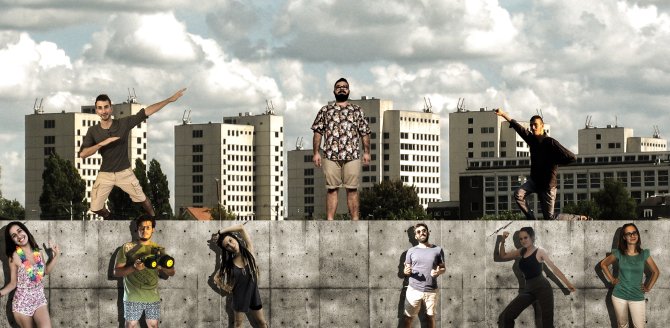
The Living Tower
By designing a Greenhouse, we took the productional part of the building as a point of origin for all the other considerations and components of this multifunctional building. It’s the combination of the visible production area occupying 1/3 of the building and the participation of the community in these in production processes that makes it work best: direct consumption of freshly-prepared, zero-kilometre food!
Therefore, we created a building which facilitates scientific progress and stimulates projects that communicate the significance of urban farming in this continuously spatially consolidated world. In order to achieve this, we designed something more than a beautiful, pleasant building; we designed a landmark: an iconic building that in all its parts, communicates the fact that food production can now be achieved in cities. It’s a building that is much more than just wood, steel and concrete; a building that itself is the Land!
We then created a truly living bio-skin: we decided to keep the old structure and replace the existing facade with a new transparent one made in ETFE, integrating a system of algae production within the cushions. As ivy grows on old abandoned buildings without affecting their structure, our new facade symbolically gets “eaten up” by nature, like green plants growing on ruins. The new envelope represents the importance and role of green in built-up areas, while breaking down the old traditions and rules. Our building wants to communicate its productional value while providing new opportunities and strategies for the integration of architecture and agriculture.
Key elements
The key innovatory aspects of our project lie in the design of a structure that integrates food production, promotes collective collaboration, and aims to reduce CO2 emissions. In our tower, we will grow 20 different types of crops using 7 different cultivation systems. The tower is home to many social activities including training courses, children’s playgrounds, creativity workshops, the Greenhouse itself, together with a VR Experience room, exhibition hall and much more.
Sustainability
At the Paris climate conference (COP21) in December 2015, 195 countries adopted the first universal and legally binding global climate agreement. The agreement defines a global action plan, with the aim of putting the world back on track to avoid dangerous climate change by limiting global warming to below 2ºC. To support this, we have implemented an ETFE wall in the tower, within which the cultivation and production of algae takes place. Thanks to photosynthesis by the algae, a large amount of CO2 is fixed in organic structures and, at the same time, oxygen is produced. This idea is already in use elsewhere, and is an exciting concept as it allows us to meet some of the global objectives of environmental sustainability. In addition, we have introduced other strategies in the tower to reduce CO2 emissions, including the sale of food inside the tower and the neighbourhood with zero-kilometre transport, and by limiting home delivery to a radius of 15 Kilometres.
Our multifunctional facade produces energy thanks to the PV-panels integrated in the ETFE cushions, and creates closed loop-systems as algae produce energy to warm water. The panels provide the energy for the pumps that distribute the water all over the building as well as for other energy needs. We use passive strategies to reduce the building’s global energy consumption: the ETFE facade is constructed as a 4-layered air cushion with an additional insulatory effect thanks to the air inside it.
Where the metallic structure replaces the ETFE, an inner facade with triple glazing covered by a layer of translucent polycarbonate made from recycled plastic sheets ensures that our envelope is thermally insulated in all parts. Inside, the automatic system allows optimal control of irrigation of the plants cultivated in the greenhouse as well as control of the greenhouse microclimate by managing the existing environmental conditioning systems. This includes opening / closing doors, the fan heating and ventilation systems, the misting system, shading sheets and lighting.
The wireless technology allows improved monitoring and management of the main environmental and crop parameters of the greenhouse, while at the same time reducing problems related to the presence of connection cables, and solving issues related to the representativeness of the measurement points.
Lessons learnt
The first lesson we learnt by participating in the Challenge was the ability to work together with students and professionals with different visions, knowledge and skills. It was extremely interesting to discover how people view and think about the current situation in the world.
Secondly, we experienced a different culture from our own Italian one, namely the Dutch: to understand what to cultivate and how to design our idea for the tower, we had to learn about the habits, traditions and dynamics of Dutch society.
The third lesson was about discovering the willpower needed and our ability to get involved in an international challenge on a very innovative and interesting theme. Many of our group had never participated in a competition on a global scale before, so the challenge has helped us to grow individually, increase our confidence, and create connections that will be valuable in the future.
Text continues under the picture

Other
The Flor-Green Team was born out of a collaboration between the universities of Bologna and Florence. While Bologna provided the main input related to agronomic skills, Florence provided the project’s architectural capabilities. This challenge has allowed us to bring together two realities that often seem to be disconnected. Prior to the green revolution, our two worlds were separate: the agricultural world was positioned in the countryside while architecture focused on the construction of cities. The global need for sustainability has therefore brought these two systems together (urban and agricultural-environmental): our team has really focused on the benefits that can be achieved by the union of agro-environmental and architectural skills.